Jacob Munkberg
NVIDIA
UniRelight: Learning Joint Decomposition and Synthesis for Video Relighting
Jun 18, 2025Abstract:We address the challenge of relighting a single image or video, a task that demands precise scene intrinsic understanding and high-quality light transport synthesis. Existing end-to-end relighting models are often limited by the scarcity of paired multi-illumination data, restricting their ability to generalize across diverse scenes. Conversely, two-stage pipelines that combine inverse and forward rendering can mitigate data requirements but are susceptible to error accumulation and often fail to produce realistic outputs under complex lighting conditions or with sophisticated materials. In this work, we introduce a general-purpose approach that jointly estimates albedo and synthesizes relit outputs in a single pass, harnessing the generative capabilities of video diffusion models. This joint formulation enhances implicit scene comprehension and facilitates the creation of realistic lighting effects and intricate material interactions, such as shadows, reflections, and transparency. Trained on synthetic multi-illumination data and extensive automatically labeled real-world videos, our model demonstrates strong generalization across diverse domains and surpasses previous methods in both visual fidelity and temporal consistency.
VideoMat: Extracting PBR Materials from Video Diffusion Models
Jun 11, 2025Abstract:We leverage finetuned video diffusion models, intrinsic decomposition of videos, and physically-based differentiable rendering to generate high quality materials for 3D models given a text prompt or a single image. We condition a video diffusion model to respect the input geometry and lighting condition. This model produces multiple views of a given 3D model with coherent material properties. Secondly, we use a recent model to extract intrinsics (base color, roughness, metallic) from the generated video. Finally, we use the intrinsics alongside the generated video in a differentiable path tracer to robustly extract PBR materials directly compatible with common content creation tools.
Generative Detail Enhancement for Physically Based Materials
Feb 19, 2025Abstract:We present a tool for enhancing the detail of physically based materials using an off-the-shelf diffusion model and inverse rendering. Our goal is to enhance the visual fidelity of materials with detail that is often tedious to author, by adding signs of wear, aging, weathering, etc. As these appearance details are often rooted in real-world processes, we leverage a generative image model trained on a large dataset of natural images with corresponding visuals in context. Starting with a given geometry, UV mapping, and basic appearance, we render multiple views of the object. We use these views, together with an appearance-defining text prompt, to condition a diffusion model. The details it generates are then backpropagated from the enhanced images to the material parameters via inverse differentiable rendering. For inverse rendering to be successful, the generated appearance has to be consistent across all the images. We propose two priors to address the multi-view consistency of the diffusion model. First, we ensure that the initial noise that seeds the diffusion process is itself consistent across views by integrating it from a view-independent UV space. Second, we enforce geometric consistency by biasing the attention mechanism via a projective constraint so that pixels attend strongly to their corresponding pixel locations in other views. Our approach does not require any training or finetuning of the diffusion model, is agnostic of the material model used, and the enhanced material properties, i.e., 2D PBR textures, can be further edited by artists.
DiffusionRenderer: Neural Inverse and Forward Rendering with Video Diffusion Models
Jan 30, 2025



Abstract:Understanding and modeling lighting effects are fundamental tasks in computer vision and graphics. Classic physically-based rendering (PBR) accurately simulates the light transport, but relies on precise scene representations--explicit 3D geometry, high-quality material properties, and lighting conditions--that are often impractical to obtain in real-world scenarios. Therefore, we introduce DiffusionRenderer, a neural approach that addresses the dual problem of inverse and forward rendering within a holistic framework. Leveraging powerful video diffusion model priors, the inverse rendering model accurately estimates G-buffers from real-world videos, providing an interface for image editing tasks, and training data for the rendering model. Conversely, our rendering model generates photorealistic images from G-buffers without explicit light transport simulation. Experiments demonstrate that DiffusionRenderer effectively approximates inverse and forwards rendering, consistently outperforming the state-of-the-art. Our model enables practical applications from a single video input--including relighting, material editing, and realistic object insertion.
Edify 3D: Scalable High-Quality 3D Asset Generation
Nov 11, 2024
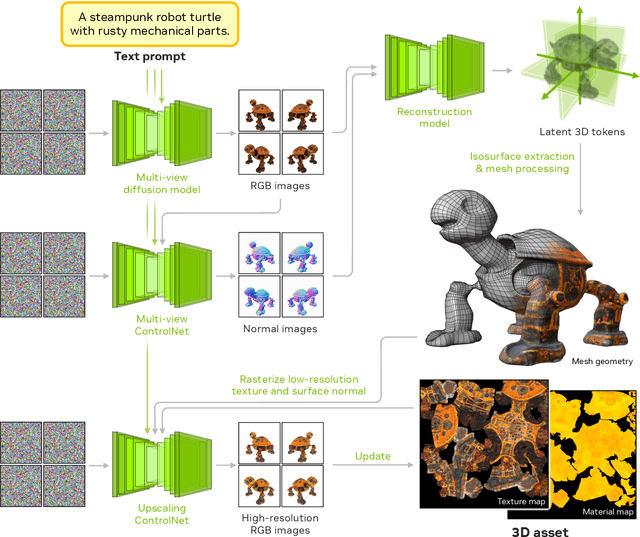
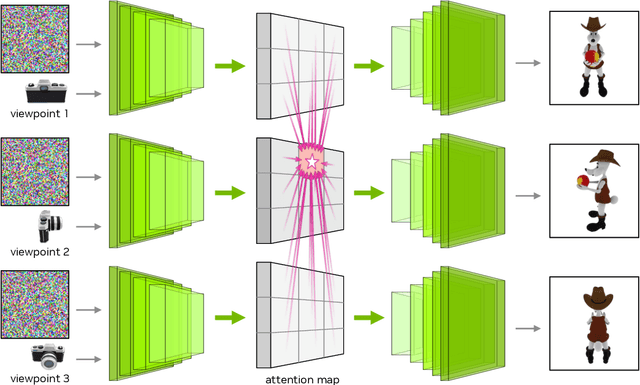
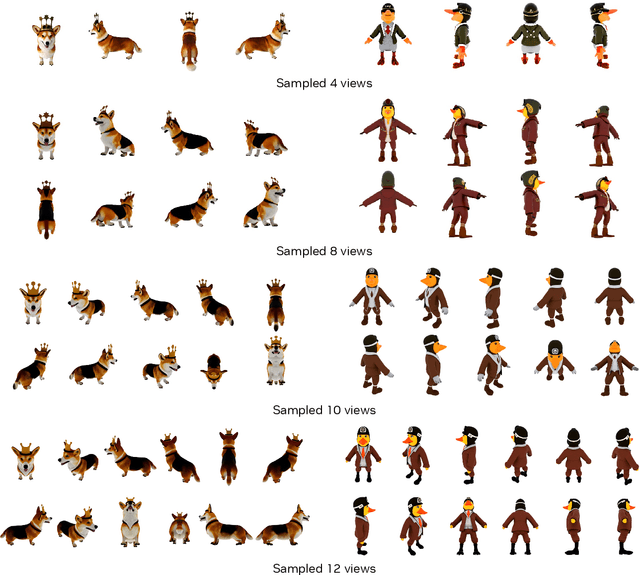
Abstract:We introduce Edify 3D, an advanced solution designed for high-quality 3D asset generation. Our method first synthesizes RGB and surface normal images of the described object at multiple viewpoints using a diffusion model. The multi-view observations are then used to reconstruct the shape, texture, and PBR materials of the object. Our method can generate high-quality 3D assets with detailed geometry, clean shape topologies, high-resolution textures, and materials within 2 minutes of runtime.
Flexible Isosurface Extraction for Gradient-Based Mesh Optimization
Aug 10, 2023Abstract:This work considers gradient-based mesh optimization, where we iteratively optimize for a 3D surface mesh by representing it as the isosurface of a scalar field, an increasingly common paradigm in applications including photogrammetry, generative modeling, and inverse physics. Existing implementations adapt classic isosurface extraction algorithms like Marching Cubes or Dual Contouring; these techniques were designed to extract meshes from fixed, known fields, and in the optimization setting they lack the degrees of freedom to represent high-quality feature-preserving meshes, or suffer from numerical instabilities. We introduce FlexiCubes, an isosurface representation specifically designed for optimizing an unknown mesh with respect to geometric, visual, or even physical objectives. Our main insight is to introduce additional carefully-chosen parameters into the representation, which allow local flexible adjustments to the extracted mesh geometry and connectivity. These parameters are updated along with the underlying scalar field via automatic differentiation when optimizing for a downstream task. We base our extraction scheme on Dual Marching Cubes for improved topological properties, and present extensions to optionally generate tetrahedral and hierarchically-adaptive meshes. Extensive experiments validate FlexiCubes on both synthetic benchmarks and real-world applications, showing that it offers significant improvements in mesh quality and geometric fidelity.
* SIGGRAPH 2023. Project page: https://research.nvidia.com/labs/toronto-ai/flexicubes/
Neural Fields meet Explicit Geometric Representation for Inverse Rendering of Urban Scenes
Apr 06, 2023Abstract:Reconstruction and intrinsic decomposition of scenes from captured imagery would enable many applications such as relighting and virtual object insertion. Recent NeRF based methods achieve impressive fidelity of 3D reconstruction, but bake the lighting and shadows into the radiance field, while mesh-based methods that facilitate intrinsic decomposition through differentiable rendering have not yet scaled to the complexity and scale of outdoor scenes. We present a novel inverse rendering framework for large urban scenes capable of jointly reconstructing the scene geometry, spatially-varying materials, and HDR lighting from a set of posed RGB images with optional depth. Specifically, we use a neural field to account for the primary rays, and use an explicit mesh (reconstructed from the underlying neural field) for modeling secondary rays that produce higher-order lighting effects such as cast shadows. By faithfully disentangling complex geometry and materials from lighting effects, our method enables photorealistic relighting with specular and shadow effects on several outdoor datasets. Moreover, it supports physics-based scene manipulations such as virtual object insertion with ray-traced shadow casting.
Shape, Light & Material Decomposition from Images using Monte Carlo Rendering and Denoising
Jun 07, 2022



Abstract:Recent advances in differentiable rendering have enabled high-quality reconstruction of 3D scenes from multi-view images. Most methods rely on simple rendering algorithms: pre-filtered direct lighting or learned representations of irradiance. We show that a more realistic shading model, incorporating ray tracing and Monte Carlo integration, substantially improves decomposition into shape, materials & lighting. Unfortunately, Monte Carlo integration provides estimates with significant noise, even at large sample counts, which makes gradient-based inverse rendering very challenging. To address this, we incorporate multiple importance sampling and denoising in a novel inverse rendering pipeline. This substantially improves convergence and enables gradient-based optimization at low sample counts. We present an efficient method to jointly reconstruct geometry (explicit triangle meshes), materials, and lighting, which substantially improves material and light separation compared to previous work. We argue that denoising can become an integral part of high quality inverse rendering pipelines.
Extracting Triangular 3D Models, Materials, and Lighting From Images
Nov 24, 2021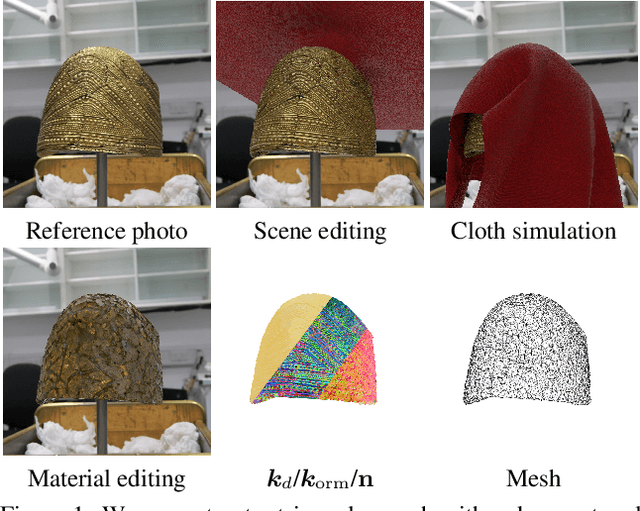
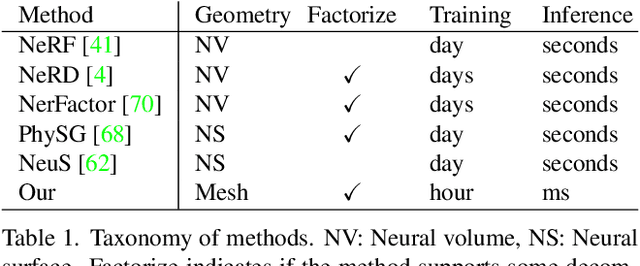


Abstract:We present an efficient method for joint optimization of topology, materials and lighting from multi-view image observations. Unlike recent multi-view reconstruction approaches, which typically produce entangled 3D representations encoded in neural networks, we output triangle meshes with spatially-varying materials and environment lighting that can be deployed in any traditional graphics engine unmodified. We leverage recent work in differentiable rendering, coordinate-based networks to compactly represent volumetric texturing, alongside differentiable marching tetrahedrons to enable gradient-based optimization directly on the surface mesh. Finally, we introduce a differentiable formulation of the split sum approximation of environment lighting to efficiently recover all-frequency lighting. Experiments show our extracted models used in advanced scene editing, material decomposition, and high quality view interpolation, all running at interactive rates in triangle-based renderers (rasterizers and path tracers).
Noise2Noise: Learning Image Restoration without Clean Data
Oct 29, 2018

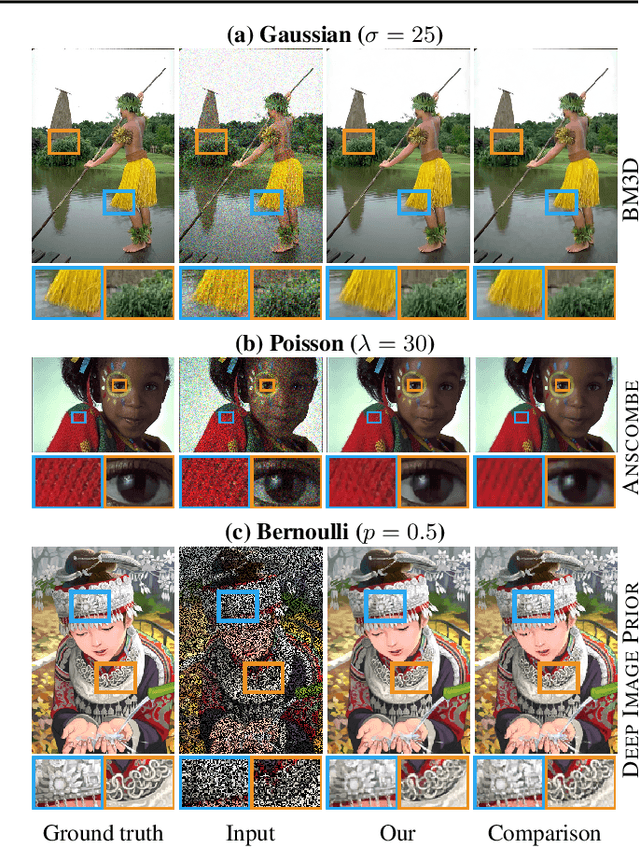
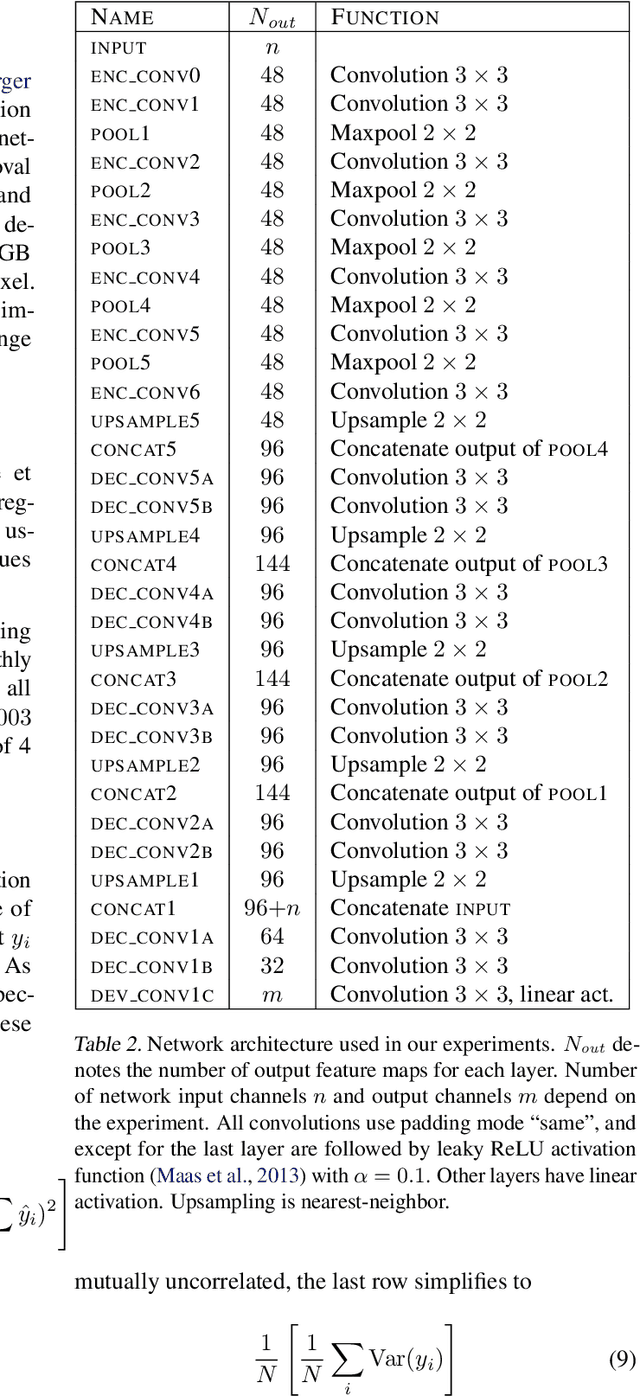
Abstract:We apply basic statistical reasoning to signal reconstruction by machine learning -- learning to map corrupted observations to clean signals -- with a simple and powerful conclusion: it is possible to learn to restore images by only looking at corrupted examples, at performance at and sometimes exceeding training using clean data, without explicit image priors or likelihood models of the corruption. In practice, we show that a single model learns photographic noise removal, denoising synthetic Monte Carlo images, and reconstruction of undersampled MRI scans -- all corrupted by different processes -- based on noisy data only.
 Add to Chrome
Add to Chrome Add to Firefox
Add to Firefox Add to Edge
Add to Edge